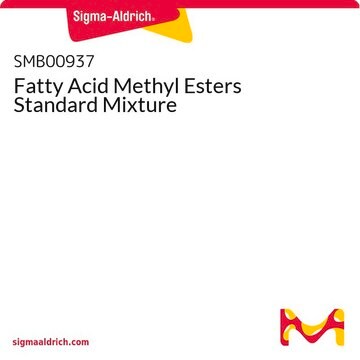MAK174
Fatty Acid Extraction Kit, Low Standard
sufficient for 40 extractions
About This Item
Recommended Products
usage
sufficient for 40 extractions
greener alternative product characteristics
Waste Prevention
Learn more about the Principles of Green Chemistry.
sustainability
Greener Alternative Product
application(s)
cosmetics
food and beverages
sample preservation
greener alternative category
, Aligned
relevant disease(s)
cancer
storage temp.
room temp
Related Categories
General description
The Folch method has been conventionally used to extract lipids containing fatty acids from biological samples, using chloroform, methanol, and water to separate lipids from aqueous-soluble compounds. In this procedure, lipids are retained in the lower chloroform layer; whereas, aqueous-soluble compounds are retained in the upper methanol-water layer. The sample is then centrifuged to achieve uniform separation and the bottom chloroform layer is transferred with a pipette to a new test tube.
Application
Suitability
Principle
We are committed to bringing you Greener Alternative Products, which adhere to one or more of The 12 Principles of Greener Chemistry. This product reduces solvent waste over traditional methods. Find details here.
Analysis Note
Other Notes
Signal Word
Danger
Hazard Statements
Precautionary Statements
Hazard Classifications
Acute Tox. 3 Inhalation - Acute Tox. 4 Dermal - Acute Tox. 4 Oral - Aquatic Chronic 3 - Carc. 2 - Eye Irrit. 2 - Flam. Liq. 2 - Repr. 2 - Skin Irrit. 2 - STOT RE 1 - STOT SE 1 - STOT SE 3
Target Organs
Central nervous system, Eyes, Liver,Kidney
Storage Class Code
3 - Flammable liquids
Flash Point(F)
49.5 °F - closed cup
Flash Point(C)
9.7 °C - closed cup
Certificates of Analysis (COA)
Search for Certificates of Analysis (COA) by entering the products Lot/Batch Number. Lot and Batch Numbers can be found on a product’s label following the words ‘Lot’ or ‘Batch’.
Already Own This Product?
Find documentation for the products that you have recently purchased in the Document Library.
Customers Also Viewed
Our team of scientists has experience in all areas of research including Life Science, Material Science, Chemical Synthesis, Chromatography, Analytical and many others.
Contact Technical Service








